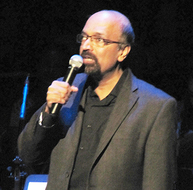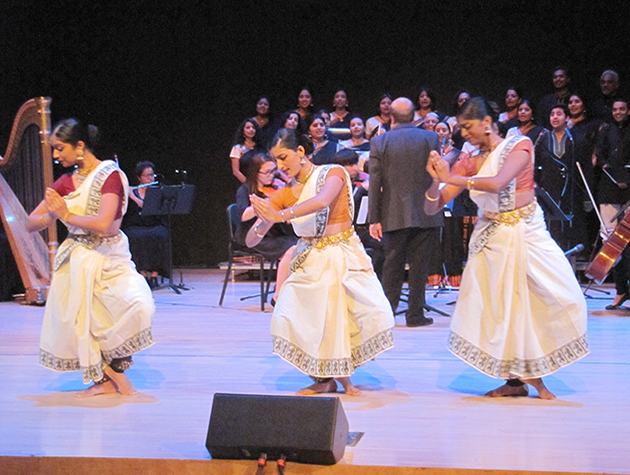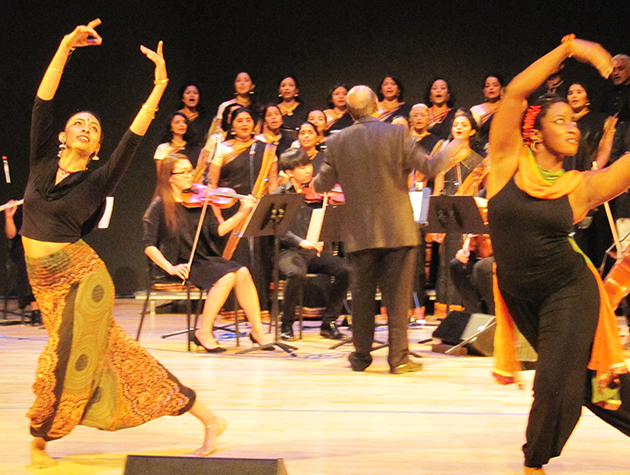
BY SONAM MURPURI
IRVINE,CA -The University of California, Irvine (UCI) presented ‘Sharad- a Musical Celebration of Autumn,’ on November 6 in the Claire Trevor School of Arts here. ‘Sharad’ is the first part of a multi-part project, ‘Dance Conversations: Dancing Communities, Dancing Cities.’This festival was presented by the Ektaa Center,
IRVINE,CA -The University of California, Irvine (UCI) presented ‘Sharad- a Musical Celebration of Autumn,’ on November 6 in the Claire Trevor School of Arts here. ‘Sharad’ is the first part of a multi-part project, ‘Dance Conversations: Dancing Communities, Dancing Cities.’This festival was presented by the Ektaa Center,

the Arpana Dance Company, and UCI’s Claire Trevor School of Arts (CTSA) Department of Music. A melodious depiction of the season of autumn was personified by artists who came together over the last six weeks to perform this amazing work of art. Women and men worked tirelessly to give the season life and explain the importance of this time of the year- autumn. It was composed, arranged, and conducted by Dr. Kanniks Kannikeswaran from Cincinnati, Ohio. Kannikes-waran is musician whose pioneering work in the area of Indian-American choral music uses the transformative power of music to build diverse communities and has led to the founding of Indian diaspora choirs in over 15 cities in North America and Europe. Los Angeles is Kannikeswaran’s 16th destination in bringing the Indian community together to perform choral music.
‘Sharad’ consisted of seven segments: Sriguruguha Dasoham (the opening invocation in raga Yaman); Ritu Chakra (duet of flute and harp in five movements in the ragas Darbari Kanada, Basant, Sarang, Malharr, and Bhairav illustrating the seasons winter, spring, monsoons, and autumn); Blessings - A Hundred Autumns (ancient Sanskrit verses invoking the blessings of the autumn season in raga Bhairav), Sharad Chandrika (a celebration of the autumn moon in raga Madhuvanti); Falling Leaves, a musical interpretation (an instrumental interlude); Shanti Mantra (ancient Vedic chants invoking peace on all aspects of creation), and finally Chaturang – Finale (in raga Charukeshi celebrating the arts). An ancient Vedic blessing “pashye ma sharad shatnam” translates into “may we live to see a hundred autumns,” stated Kannikeswaran.
Personifying this season were artists from various backgrounds all dressed mainly in black. Some of the musical pieces were brought to life at various times by nine different women who came on stage in groups or individually to gracefully dance and personify the music the choir was singing. By definition, the term ‘Sharad’ means autumn. Ancient Indian scriptures hold the season of autumn to a higher regard because it is considered to be a season of reflection and meditation. Autumn is “the fiery heat of the summer making way for the powerful monsoon season which in turn leads to a cool autumn season. The autumn season facilitates the human mind to let go of the old and make room for the new.” A one of a kind musical genre pioneered by Kannikeswaran, choral and orchestral music is mainly based on the ragas associated with the season of autumn. ‘Sharad’ exemplifies the meditative and celebrative spirit of the season. After a year of performances anywhere, ‘Sharad’ came to Los Angeles. ‘Sharad’ originally premiered in The Hague, Netherlands in 2013 and was performed by the newly formed Surinamese Indian Choir as well as having been performed by the local community in Tampa, Florida in 2014. Look forward to more “Dance Conversations” coming in 2016 featuring Kalpana Raghuraman, a talented choreographer from Brussels, to continue the conversation with dance.
‘Sharad’ consisted of seven segments: Sriguruguha Dasoham (the opening invocation in raga Yaman); Ritu Chakra (duet of flute and harp in five movements in the ragas Darbari Kanada, Basant, Sarang, Malharr, and Bhairav illustrating the seasons winter, spring, monsoons, and autumn); Blessings - A Hundred Autumns (ancient Sanskrit verses invoking the blessings of the autumn season in raga Bhairav), Sharad Chandrika (a celebration of the autumn moon in raga Madhuvanti); Falling Leaves, a musical interpretation (an instrumental interlude); Shanti Mantra (ancient Vedic chants invoking peace on all aspects of creation), and finally Chaturang – Finale (in raga Charukeshi celebrating the arts). An ancient Vedic blessing “pashye ma sharad shatnam” translates into “may we live to see a hundred autumns,” stated Kannikeswaran.
Personifying this season were artists from various backgrounds all dressed mainly in black. Some of the musical pieces were brought to life at various times by nine different women who came on stage in groups or individually to gracefully dance and personify the music the choir was singing. By definition, the term ‘Sharad’ means autumn. Ancient Indian scriptures hold the season of autumn to a higher regard because it is considered to be a season of reflection and meditation. Autumn is “the fiery heat of the summer making way for the powerful monsoon season which in turn leads to a cool autumn season. The autumn season facilitates the human mind to let go of the old and make room for the new.” A one of a kind musical genre pioneered by Kannikeswaran, choral and orchestral music is mainly based on the ragas associated with the season of autumn. ‘Sharad’ exemplifies the meditative and celebrative spirit of the season. After a year of performances anywhere, ‘Sharad’ came to Los Angeles. ‘Sharad’ originally premiered in The Hague, Netherlands in 2013 and was performed by the newly formed Surinamese Indian Choir as well as having been performed by the local community in Tampa, Florida in 2014. Look forward to more “Dance Conversations” coming in 2016 featuring Kalpana Raghuraman, a talented choreographer from Brussels, to continue the conversation with dance.



 RSS Feed
RSS Feed
